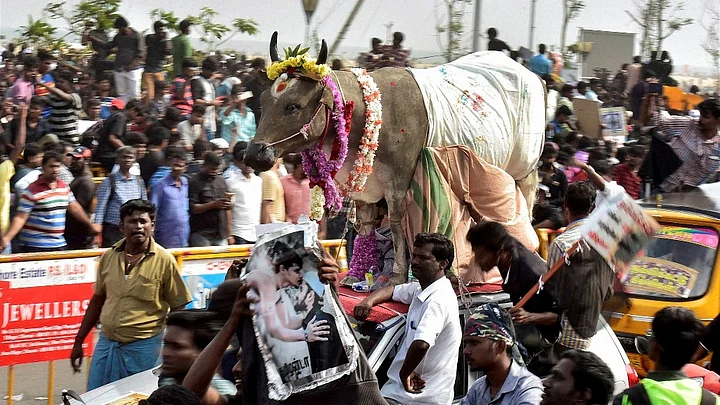When Tamil Nadu Chief Minister O Panneerselvam promised Tamil Nadu that the vaadivasal will be opened and the bulls will be let loose to run in Jallikattu soon, the protests in Tamil Nadu only intensified. For the fourth day in a row, tens of thousands thronged Marina beach in Chennai, protesting against the ban, and much more.
The morning saw a crowd of not more than a few thousand people. But by 1 pm, it had ballooned into a massive rally, with tens of thousands of youngsters dressed in black laying siege to Marina. Traffic was held from the Beach road all the way up to Stella Maris College through Cathedral road. From Chennai Central Station to Santhome through the Beach road, it was a sea of black – young and old.
Wounds of Tamil Eelam Haven’t Healed Yet
The protest is no longer, and perhaps never was, only about Jalikattu. It has, however, become the rallying point for disgruntlement of the Tamil people, from Tamil Eelam to Cauvery river water-sharing, helped by the general discontent over demonetisation.
The slogans raised, the posters displayed and the beach-side conversations are testimony to the different issues being raised in Tamil Nadu. And couched in the calls for justice is victimhood, the eternal lament of being a Tamil and ‘Indian government’ never caring for it.
The wounds of Tamil Eelam have not healed yet, and the Cauvery issue is still simmering, sure to return to test our democratic institution’s next crop cycle. And it isn’t just Cauvery, the Thamirabarani crisis and issues of Pepsi and Coke sucking the river dry also made a frequent appearance at Marina.
Several posters of slain LTTE chief Prabhakaran were also seen at the protests. All these issues tie up, and that is why there is such mass outpouring, says 36-year-old Selvakumar, a professor. “It may not be relevant today, but this shows why so many people are out here. Tamilians and our issues are never taken seriously,” he says.
A group of ten boys from the near fishing hamlets have also come. Dressed in black, and some sporting a fish-shaped gold locket on their necks, they are busy patching together an effigy to burn it. “You know how many Tamil fishermen are killed or arrested by Sri Lanka every month?” one of them asks angrily.
Anger Targeting Everybody
The grammar of the protests and choice of black clothing does remind one of Tamil pop politics’ roots in the Dravidian movement. But just to be sure that believers in Revolutionary Marxism and Periyarists are a significant part of the protests, there are posters of Che and Periyar too.
The anger is democratic, in that it is targeted at everybody.
Chief Minister O Panneerselvam was mocked mercilessly. There were the protests, slogans and posters, but the highlight of his mockery was when a college student, dressed in white and sporting grey hair, zoomed ahead as the pillion rider on the bike, eating mixture. (OPS has been a part of several ‘mixture memes’, remember that scene in ‘Nattamai’?)
Sasikala got her share of abuses in the slogans too, with a few personal insults coming her way.
But the worst of the sloganeering, caustic remarks and unpublishable expletives were directed at Narendra Modi. Posters were mutilated, effigies burnt and several mock funeral processions of Modi taken out.
Subramaniam Swamy was not spared too, thanks to his ‘porrikis’ remark.
The increasing decibel levels of abuse and expletives are slowly taking off the veneer of dignity these protests initially had. While protesters remain kind to each other, lending a helping hand, the protests seem to be taking a more aggressive stand.
(At The Quint, we question everything. Play an active role in shaping our journalism by becoming a member today.)
